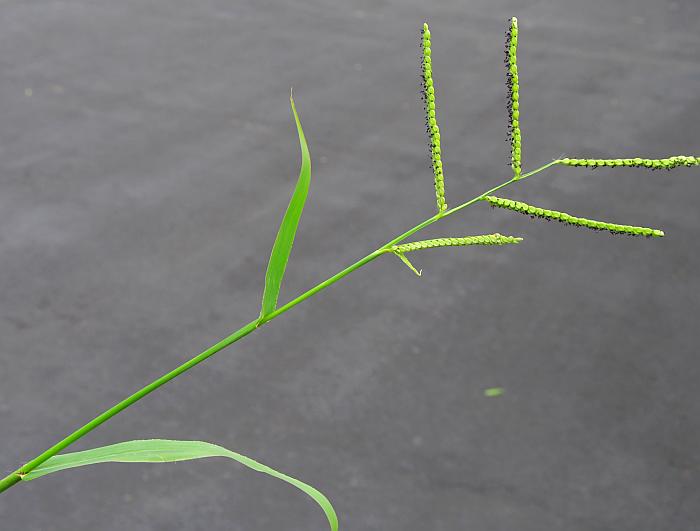Paspalum pubiflorum Rupr. ex E. Fourn.
Hairy-Seed Bead Grass

Native
CC = 3
CW = 0
MOC = 62
© SRTurner
Paspalum pubiflorum Rupr. ex E. Fourn.Hairy-Seed Bead Grass | |
 |
Native CC = 3 CW = 0 MOC = 62 |
© SRTurner |
|
Family - Poaceae/Paniceae Habit - Perennial grass, without rhizomes, forming tufts or clumps, with C4 photosynthesis. Stem - Ascending from usually spreading bases, to 1 m, sometimes rooting at lower nodes, glabrous or nearly so.
Leaves - Leaf sheaths glabrous or the lowermost ones sparsely hairy, the ligule membranous, 0.8-2.5 mm long. Leaf blades 5-30 cm long, 4-15 mm wide, usually sparsely hairy toward the base.
Inflorescences - Panicles with 3-10 spikelike branches mostly more than 2 cm apart along the main axis. Spikelike branches 4-11 cm long, erect to spreading, one-sided with a persistent axis, with a spikelet at the tip, narrower than the band of spikelets, the spikelets dense and mostly strongly overlapping along the axis, mostly in 2 rows of paired spikelets, appearing as in 4 rows.
Spikelets - Elliptic-ovate in outline, 2.8-3.2 mm long, rounded or bluntly pointed at the tip. Lower glume absent. Upper glume 2.6-3.2 mm long, elliptic-ovate, rounded to bluntly pointed at the tip, 3-7-nerved, glabrous or nearly so. Sterile floret with the lemma 2.6-3.2 mm long, elliptic-ovate, rounded to bluntly pointed at the tip, 5-7-nerved, glabrous. Fertile floret with the lemma 2.4-3.0 mm long, elliptic. Anthers 0.8-1.2 mm long, black.
Fruits - Caryopses broadly oblong-elliptic in outline. Flowering - June - September. Habitat - Upland prairies, bottomland forests, pond margins, streambanks, pastures, fields, lawns, ditches, roadsides, railroads, moist, open, disturbed areas. Origin - Native to the U.S. Lookalikes - Other species of Paspalum, especially P. floridanum, P. setaceum, P. laeve, and others. Other info. - The generic term "bead grass" seems appropriate to grasses in this genus, as they generally present their spikelets in neat rows resembling tiny beads crowded on a string. Identification to species is a little more difficult. Important features of this species include several spikelike branches on the inflorescence, branch axes which are narrower than the rows of spikelets (such that the spikelets are easily visible from above), and rows of spikelets which appear 4-ranked. Steyermark also noted the tendency of the lower stems to recline along the ground, sometimes rooting. All of these characters are somewhat variable and can confound a confident determination. Spikelet length (2.8-3.2 mm) is also a good character for identification but requires either a microscope and microruler or else lots of experience to evaluate. Photographs taken at Don Robinson State Park, Jefferson County, MO, 9-2-2021, and near Labadie, Franklin County, MO, 9-3-2021 (SRTurner). |